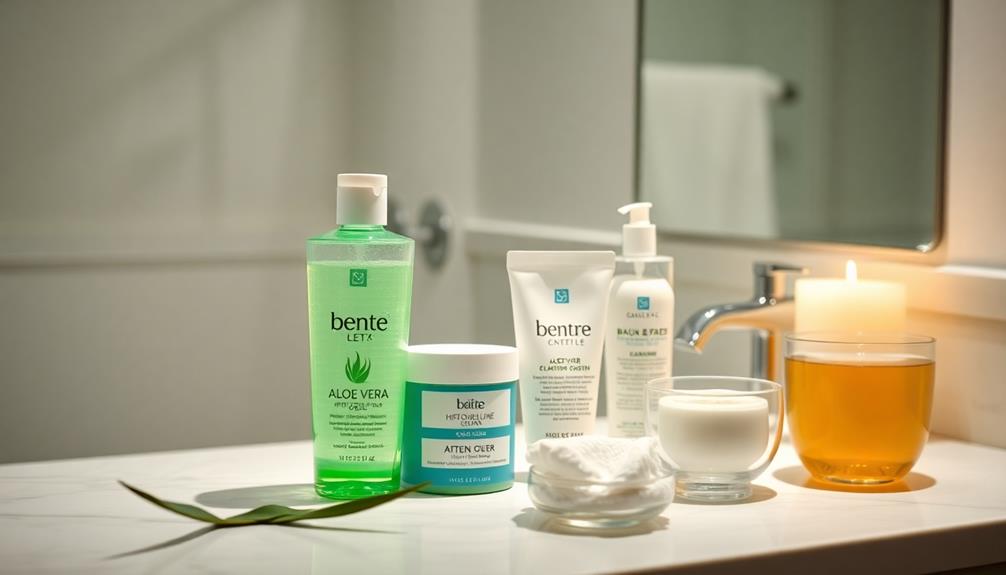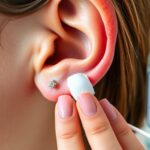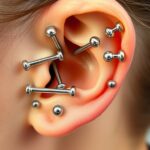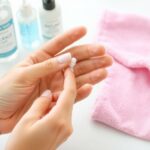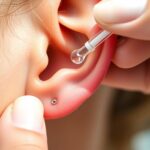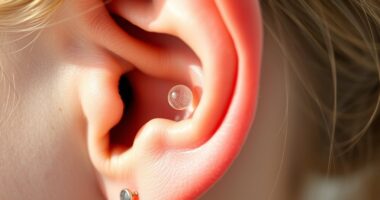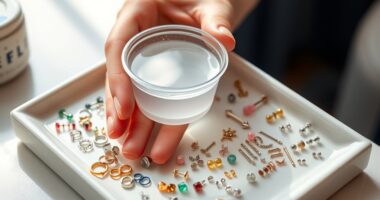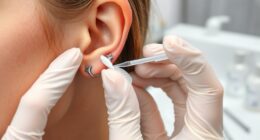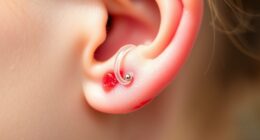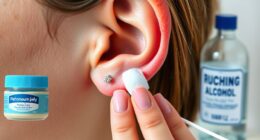Aftercare is essential for your healing process if you have sensitive skin. Use hypoallergenic, alcohol-free products to avoid irritation, and clean your piercing 2-3 times daily with a sterile saline solution. Keep an eye out for signs of redness or swelling, as these could indicate irritation. Avoid harsh cleansers and over-cleaning, which can dry out your skin. Stick to jewelry made of inert metals like titanium or surgical steel to minimize allergic reactions. Following these guidelines will promote a smoother healing experience and comfort. There's more you can discover about effective aftercare and healing processes tailored for sensitive skin.
Key Takeaways
- Use sterile saline solutions, free from additives, to clean the piercing 2-3 times daily for optimal healing.
- Choose hypoallergenic jewelry materials like titanium or surgical stainless steel to minimize irritation for sensitive skin.
- Monitor for signs of irritation, such as redness or swelling, and consult a professional if symptoms persist.
- Avoid harsh cleaning agents, including alcohol and hydrogen peroxide, to prevent further irritation and discomfort.
- Join community resources or support groups for shared experiences and advice on aftercare for sensitive skin types.
Importance of Aftercare for Sensitive Skin
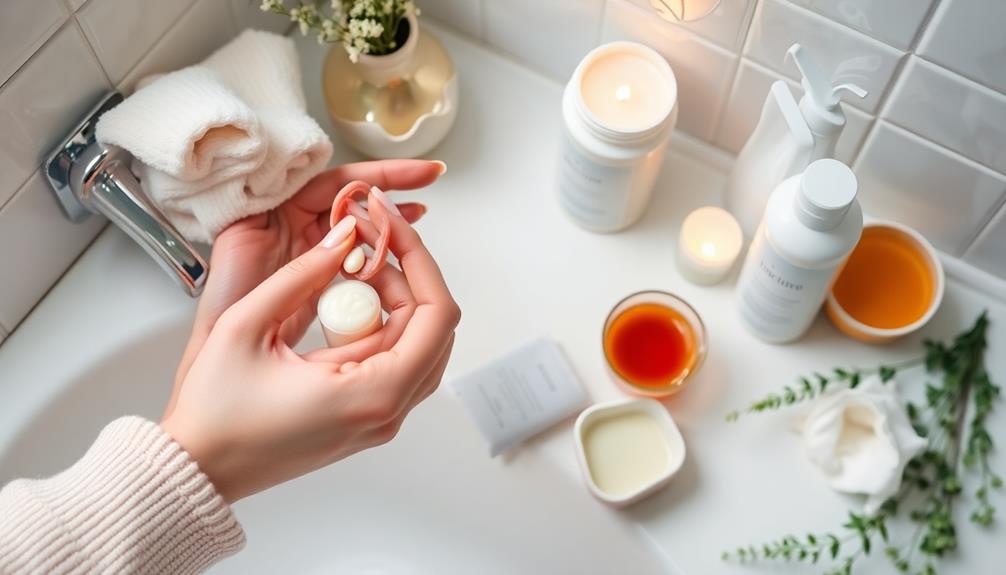
Understanding the importance of aftercare for sensitive skin is critical to guaranteeing a smooth healing process after getting pierced. If you have sensitive skin, the right aftercare can prevent irritation and allergic reactions that might arise from harsh chemicals or fragrances in some products.
Opt for hypoallergenic and alcohol-free options that can cleanse and calm your skin without adding discomfort. Regularly using a sterile saline solution to clean your piercing site helps maintain hygiene while reducing the risk of infection.
This is especially important for sensitive skin, as it may react adversely to infections. Stick to a gentle cleaning routine, avoiding over-cleaning, which can lead to dryness and irritation.
It's also significant to monitor your skin closely. Watch for any signs of irritation or allergic reactions, like redness or swelling. Early intervention can prevent complications and promote faster healing.
Recommended Cleaning Solutions
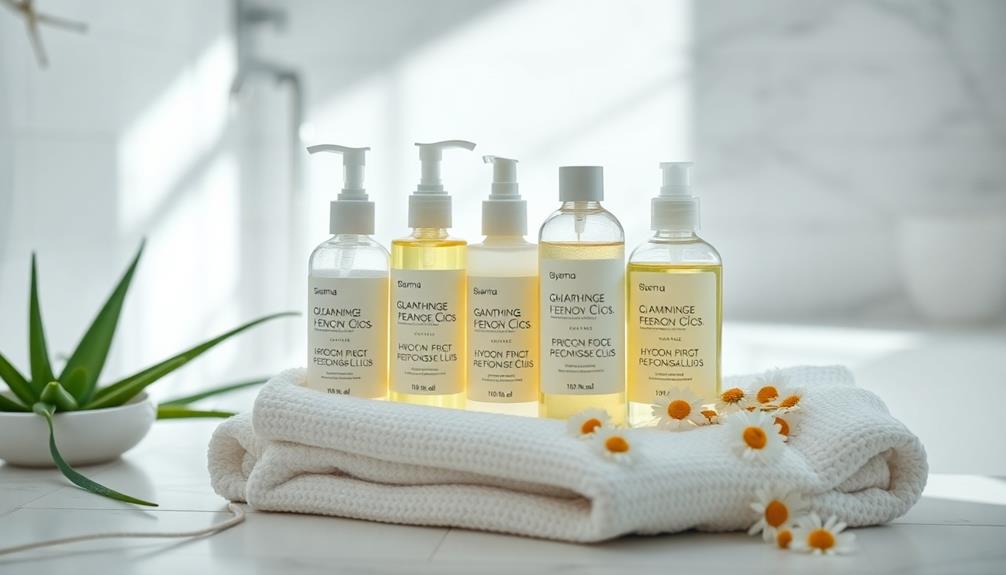
When caring for a new piercing on sensitive skin, choosing the right cleaning solution is crucial for a smooth healing process. It's recommended to use sterile saline solutions labeled for wound wash, containing 0.09% sodium chloride. These solutions help avoid irritation and promote healing without any added ingredients that could trigger sensitivity reactions.
Avoid cleaning products with moisturizers, antibacterials, or additives, as these can interfere with the healing process. Consider gentle saline sprays like Studex Advanced 2-in-1 Piercing Aftercare & Cleanser, which is specifically designed for sensitive skin and features a hypoallergenic formula safe for daily use.
Always remember to wash your hands thoroughly before touching your piercing. Apply the saline solution using a sterile gauze pad or cotton swab to minimize the risk of contamination.
Regularly clean the piercing site 2-3 times a day with your chosen saline solution. This consistent aftercare helps prevent irritation and supports ideal healing. By following these aftercare instructions, you can guarantee your sensitive skin and new piercing heal beautifully.
Normal Healing Process

When you get a piercing, you'll experience common healing symptoms like swelling and tenderness at first, followed by some discoloration and itching.
It's important to know that healing times can vary, with ear piercings taking around 6 to 8 weeks, while cartilage piercings may take longer.
Proper aftercare is essential, especially for sensitive skin, to guarantee everything heals smoothly without complications.
Common Healing Symptoms
As you navigate the healing process of your new piercing, it's normal to encounter various symptoms that signal your body's response to the procedure. Common healing symptoms include bleeding, swelling, tenderness, and bruising, all of which are typical reactions to the trauma caused by the piercing.
As you move through the initial healing period, you might also notice discoloration and itching. A whitish-yellow secretion may appear, indicating that your body is working hard to heal the area.
Remember, piercings heal from the outside in, so patience is key as the internal tissue takes longer to recover. During this time, it's essential to use appropriate care products to maintain cleanliness. Regular cleaning helps prevent the accumulation of secretions and odors, which can lead to irritation if neglected.
It's important to resist the urge to force movement of your jewelry once the piercing seems healed, as this can cause complications.
Understanding these common healing symptoms will help you navigate your aftercare with confidence, ensuring a smoother healing journey for your sensitive skin.
Healing Time Expectations
Healing times for piercings can vary considerably based on the type and placement of the piercing. For instance, ear piercings typically heal within 6 to 8 weeks, while cartilage piercings may take 3 to 6 months due to lower blood circulation in that area.
Understanding these healing time expectations is essential for sensitive skin types, as you may experience specific symptoms during the process.
Here are some key points to keep in mind:
- Initial Symptoms: You might notice bleeding, swelling, or tenderness; these are normal but should decrease over time.
- Discoloration and Itching: As your piercing heals, it's common to see some discoloration or experience itching—this is part of the healing process.
- Secretion: A whitish-yellow secretion may occur, which is also normal and indicates your body's natural healing response.
- Jewelry Movement: Once healed, jewelry won't move freely. Avoid forcing movement to prevent irritation or reopening the wound.
Aftercare for Sensitivity
Caring for your piercing is fundamental, especially if you have sensitive skin. To minimize irritation and promote healing, opt for hypoallergenic aftercare products, particularly those containing high purity hypochlorous.
Cleaning your piercing 2-3 times daily with a sterile saline solution is essential; this helps prevent infection while supporting the normal healing process without further aggravating your skin sensitivity.
Steer clear of harsh cleaning agents like alcohol and hydrogen peroxide, as they can worsen skin irritation and extend your healing time.
It's also important to maintain a skin-neutral pH in your aftercare products, as this helps cleanse, calm, and protect the piercing area without causing discomfort.
Keep a close eye on any signs of irritation, such as increased redness or swelling. If you notice these symptoms, don't hesitate to consult a professional piercer or a board-certified dermatologist for tailored aftercare advice.
They can provide you with specific recommendations to guarantee your piercing heals well while accommodating your sensitive skin.
Common Mistakes to Avoid

Many people make critical mistakes when it comes to piercing aftercare for sensitive skin, which can hinder the healing process. To guarantee your piercing heals properly, here are some common mistakes to avoid:
- Using Harsh Products: Avoid alcohol, hydrogen peroxide, or soaps with fragrances. These can cause irritation and prolong healing. Stick to a gentle piercing aftercare spray instead.
- Over-Cleaning: It might seem like a good idea to clean your piercing frequently, but overdoing it can lead to dryness and irritation. Aim to keep the piercing clean without excessive scrubbing.
- Touching or Rotating Jewelry: Resist the urge to touch or rotate your jewelry. This can create trauma around the piercing, increasing the risk of irritation.
- Choosing the Wrong Jewelry: Make sure to select jewelry made from hypoallergenic materials like titanium or surgical steel. This helps prevent allergic reactions and keeps your skin happy.
Signs of Infection

Infections can pose a serious threat to the healing process of your piercing, especially if you have sensitive skin. Recognizing the signs of infection early can make a significant difference in your recovery. Here are some key indicators to watch out for:
| Sign | Description | Action |
|---|---|---|
| Persistent Pain | Pain that occurs without contact or pressure | Consult a professional |
| Increasing Redness | Redness that spreads beyond the initial site | Monitor closely |
| Drainage | Yellow fluid or pus indicating possible infection | Seek medical advice |
| Granulation Tissue | Raised, bumpy tissue around the piercing | Evaluate for irritation |
If you notice warmth to the touch at the site, it could indicate inflammation. Prolonged bleeding or swelling past the initial healing phase is also a red flag. Ignoring these signs can lead to complications like keloids or closure of the piercing. Always be vigilant; your skin deserves the best care during the healing process.
Best Practices for Different Piercings
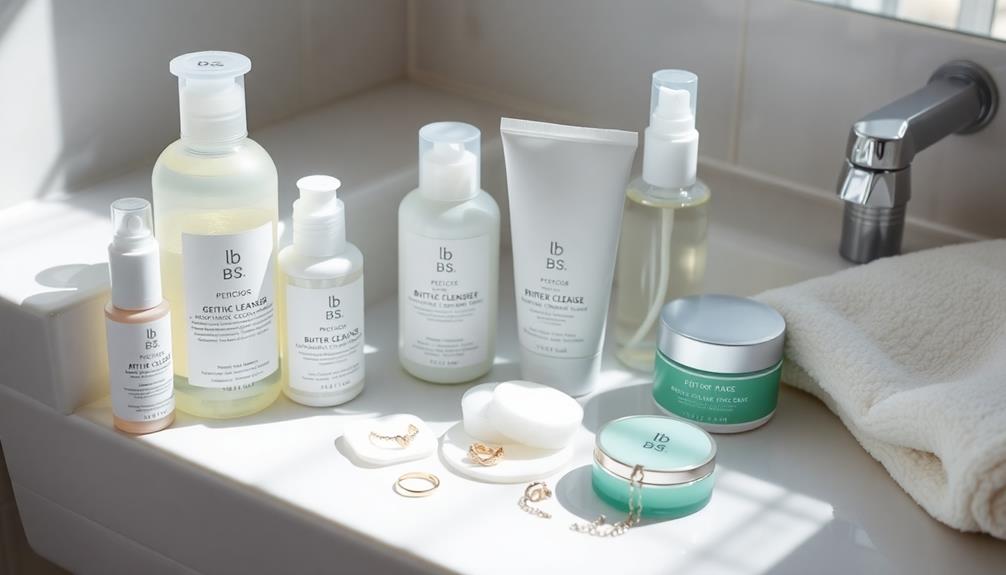
When it comes to aftercare for your piercings, understanding healing times and jewelry materials is essential.
Different piercings have varying healing periods, and using the right materials can prevent complications, especially on sensitive skin.
Healing Times for Piercings
How long should you expect to wait for your piercings to heal? Healing times can vary appreciably depending on the type of body piercings you have.
It's vital to follow proper aftercare routines to minimize irritation and guarantee a smooth healing process.
Here's a quick guide to help you understand the healing times for different piercings:
- Earlobe Piercings: Typically heal in 6-8 weeks.
- Helix Piercings: May take up to 8 weeks due to their location on the cartilage.
- Nose Piercings: Generally require 2-4 months as they heal slower because of lower vascularity in nasal cartilage.
- Cartilage Piercings (like tragus or conch): Can take anywhere from 3-6 months, so diligent aftercare is necessary.
Jewelry Material Considerations
Choosing the right jewelry material is vital for a successful healing process, especially if you have sensitive skin. Opt for inert metals like titanium and surgical stainless steel, as they're less likely to cause irritation or allergic reactions. Avoid cheaper metals, particularly those containing nickel, which can aggravate sensitive skin.
For new piercings, solid gold (at least 14k) is a safe choice. It's hypoallergenic and minimizes the risk of skin reactions, making it ideal for those with sensitivities. Platinum is another excellent option due to its non-reactive nature and durability, perfect for various piercings, including cartilage and lobes.
Stay away from mixed metals like bronze or brass; they can provoke allergic responses and irritate sensitive skin, complicating the healing process.
It's important to consult with a professional piercer to discuss your individual skin sensitivities and the specific type of piercing you're considering. They can help you choose appropriate jewelry materials and guarantee the best chance for a smooth recovery.
Prioritizing the right metal won't only enhance your comfort but also contribute to a successful healing experience.
Community Resources and Support

Steering through the world of piercing aftercare for sensitive skin can feel overwhelming, but you're not alone. Many community resources can guide you on your journey to healing.
Engaging with others who share similar experiences can be incredibly helpful, especially when dealing with emotional aspects of self-care and personal well-being, similar to maneuvering narcissistic relationships.
Here are some resources you might find valuable:
- Local Piercing Studios: Many offer support groups where you can share experiences and learn about aftercare practices specific to sensitive skin.
- Online Forums & Social Media Groups: Join communities dedicated to body piercing. You'll find tips and insights tailored for those with sensitive skin.
- Association of Professional Piercers (APP): This organization provides educational materials and guidelines that can help you understand the best aftercare practices.
- Workshops by Dermatologists: Look for sessions hosted by skincare professionals focusing on piercing aftercare, specifically addressing sensitive skin concerns.
Additionally, community feedback on piercing aftercare products, especially those featuring HypoBiome Technology™, can help you choose the gentlest options available.
Frequently Asked Questions
What Piercing Is Good for Sensitive Skin?
If you've got sensitive skin, consider earlobe piercings for lower irritation risks. Helix and conch piercings can work too, but you'll want to use hypoallergenic jewelry and consult a specialist for the best results.
Can People With Sensitive Skin Get Piercings?
Yes, you can get piercings, and you should choose wisely. Opt for hypoallergenic materials, consult a professional, and prepare your skin. With the right care, you'll enjoy your new piercing without unnecessary irritation.
What Is the Best Aftercare for Piercings?
To care for your piercing, clean it daily with a saline solution, avoid harsh products, and gently use sterile materials. Keeping your jewelry clean and choosing safe metals will promote healing and reduce irritation.
What Is the Best Jewelry for Piercings on Sensitive Skin?
You'll find that titanium, surgical stainless steel, and high-karat gold are your best bets for piercings if you've got sensitive skin. These materials minimize irritation, ensuring your jewelry feels comfortable and looks great.
Conclusion
In conclusion, taking care of your piercings is essential, especially if you have sensitive skin. By using gentle cleaning solutions and avoiding common mistakes, you can promote healing and reduce the risk of infection. For instance, imagine Sarah, who neglected her aftercare and ended up with an infection that required medical attention. Don't let that be you! Stay informed and connected with community resources to guarantee your piercing journey is safe and successful.

